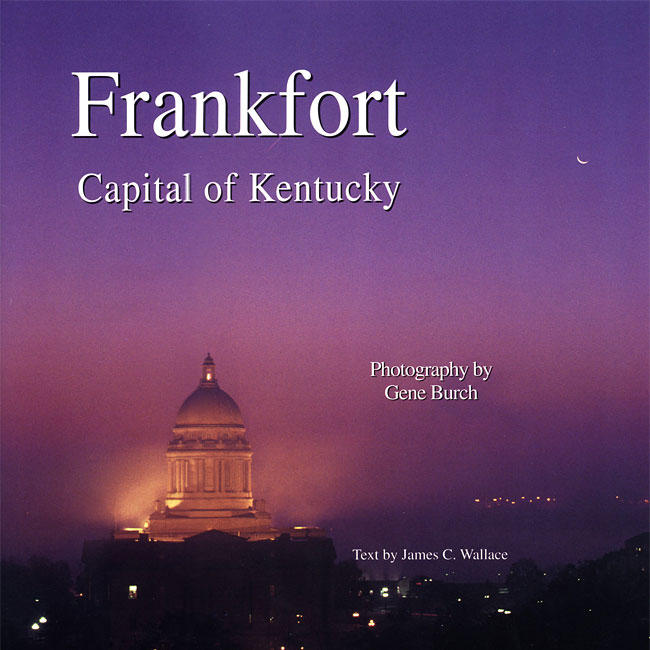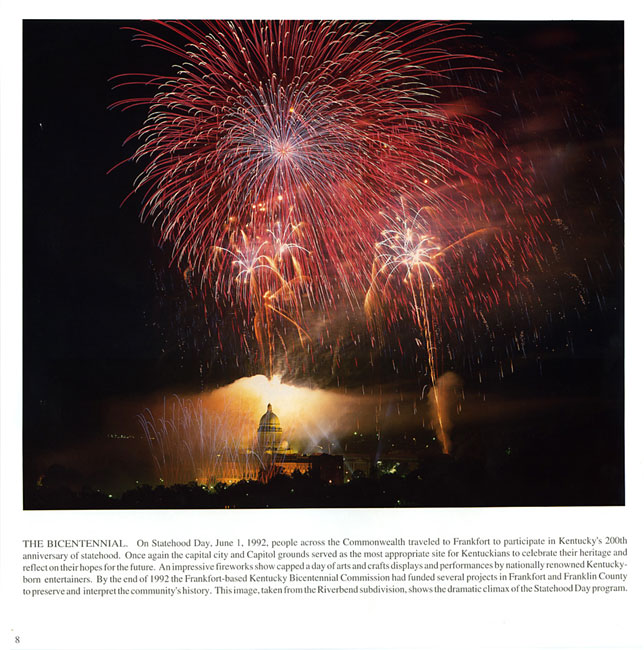
Introduction
Daniel Boone always looked for a “high, far-seeing place” when he was about to venture into strange land. Fittingly, the graves of Boone and his wife, Rebecca, rest on such a “far-seeing place” in the Frankfort Cemetery, nestled high atop a limestone cliff overlooking Kentucky’s picturesque capital city. From this tranquil vantage point, a sweeping view of this quaint Kentucky town meets a visitor’s eyes. The scene is filled with trees, church steeples, and the majestic domes of public buildings settled snugly along the S-shaped bend of the Kentucky River. The rolling Bluegrass countryside that so enchanted Boone and other early settlers lies in the background. This peaceful modern scene belies the colorful and sometimes turbulent history of this spunky town. Frankfort’s rich past is a gristmill for novelists, poets, and painters, and the city is a historic treasure trove for curious travelers.
A good place to get a sense of the personalities that have decorated Frankfort’s history is the so-called “Corner in Celebrities” in the north part of town, an older section along the top bend of the S in the river. This single square block lays claim to more historic one-time residents than any other similar area in the state. Residents have included governors, senators, congressmen, generals, admirals, Supreme Court justices, and members of presidential cabinets. The scheming Revolutionary War hero James Wilkinson, who laid out Frankfort in 1786 with a charter from the Virginia legislature, and former Vice President Aaron Burr, who was first charged with treason in a Frankfort federal court, both owned land in the “Corner.” The area was also home to the eloquent lawyer who coined the phrase “dog is man’s best friend” in a successful court argument as well as the backyard gardener who developed Bibb lettuce. The presence of six former presidents, France’s General Lafayette and Prince Louis Philippe, and numerous other prominent people from history can be felt in Liberty Hall and in the adjacent Orlando Brown House on the edge of the “Comer”.
Liberty Hall, one of the oldest and finest houses in town, was begun in 1796 by John Brown, who became one of the state’s first two United States senators when Kentucky was made a state in 1792. The Orlando Brown House, a gift from Brown to his son, was completed in 1830. The structure is a fine example of the Greek Revival architecture that was just then emerging in Kentucky. The Orlando Brown House was designed by young architect Gideon Shryock, whose first major work in town was the Old State Capitol, one block over from Broadway. Greek Revival was thus introduced to the frontier. The limestone building, patterned after a Greek temple, was built between 1825 and 1830 on the site of two previous log capitols that burned. The Old Capitol served as Kentucky’s seat of government until 1910. The structure has been faithfully restored to its original appearance when it was Kentucky’s statehouse. The adjacent office annex houses the state History Museum. Standing in front of the building one is reminded of the often tumultuous past of the town that was originally called Frank’s Ford. The story passed down to modern times is that a pioneer named Stephen Frank was killed in an Indian raid in 1780 at a ford in the river where Frankfort was later settled.
Page Samples




